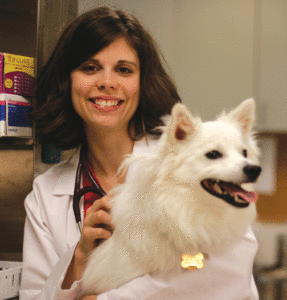-
Adopt
-
Veterinary Care
Services
Client Information
- What to Expect – Angell Boston
- Client Rights and Responsibilities
- Payments / Financial Assistance
- Pharmacy
- Client Policies
- Our Doctors
- Grief Support / Counseling
- Directions and Parking
- Helpful “How-to” Pet Care
Online Payments
Referrals
- Referral Forms/Contact
- Direct Connect
- Referring Veterinarian Portal
- Clinical Articles
- Partners in Care Newsletter
CE, Internships & Alumni Info
CE Seminar Schedule
Emergency: Boston
Emergency: Waltham
Poison Control Hotline
-
Programs & Resources
- Careers
-
Donate Now
 by Shawn Kearns, DVM, DACVIM
by Shawn Kearns, DVM, DACVIM
internalmedicine@angell.org
617-541-5186
www.angell.org/internalmedicine
Case summary: Frieda, a 10-year-old FS DLH, presented primarily for evaluation of polyuria and polydipsia. Initial blood work and urinalysis were unremarkable other than mild hypernatremia and hyposthenuria (1.007). Ultrasound noted the adrenal glands were at the upper limits of normal. Over 4 months, Frieda developed insulin-resistant diabetes mellitus. A low dose dexamethasone test was performed and lacked suppression, supporting a diagnosis of hyperadrenocorticism (HAC). Frieda was started on trilostane 2mg/kg BID. She has since come off insulin therapy and has been doing well clinically with good control based on ACTH stimulation for monitoring.
Feline hyperadrenocorticism (HAC) is a rare disease affecting usually middle aged to older patients. Many signs are similar to canine HAC (PU/PD, symmetric alopecia, infections and peripheral neuropathy). Cats, however, also can suffer from a skin fragility syndrome and insulin-resistant diabetes is also common with cats. The skin fragility may be so severe that simple restraint or grooming may tear the skin.
Results of initial blood testing including a CBC, general profile and urinalysis may be unremarkable, though most often these patients have changes consistent with diabetes mellitus. Increased ALP, ALT, cholesterol and glucose are common. Acromegaly is another differential for insulin resistance and can usually be excluded with testing such as IGF-1; patients with acromegaly do not suffer from skin fragility.
The urine cortisol:creatinine ratio (UCCR) is a useful screening test for HAC, as in dogs, and should ideally be collected at home on 2 consecutive days. An alternative ‘at home’ oral dexamethasone suppression test has been suggested in dogs and may be considered in cats, especially those with skin fragility syndrome. The owner is instructed to collect 2 urine samples from the patient on 2 consecutive mornings and store them in the refrigerator. After collection of the second urine sample, the owner should administer 3 doses of dexamethasone (0.1 mg/kg/dose) orally at 8-hour intervals. Urine is collected on the morning of the third day and UCCR is determined on all 3 samples. The first 2 urine samples establish the diagnosis of hyperadrenocorticism; both results must be abnormal. If both values are abnormal, then the average of the 2 values is used as the ‘baseline’ value and compared with the third value obtained after dexamethasone administration. A diagnosis of pituitary-dependent hyperadrenocorticism (PDH) is established if the UCCR result from the third urine sample is less than 50% of the ‘baseline’ value. Patients failing to meet these criteria could have either adrenal-dependent hyperadrenocorticism (ADH) or PDH.
The ACTH stimulation test is not a sensitive test in cats as it is only abnormal in 50–60% of cats with HAC. The low dose dexamethasone test is considered to be the test of choice for diagnosis of feline HAC and is performed using a higher dose of dexamethasone (0.1 mg/kg IV) than in the dog. Cortisol concentrations will be suppressed at 8 hours in normal cats, but not in cats with HAC. Most often, additional testing such as abdominal ultrasound or a high dose-dexamethasone test is needed for differentiation of pituitary versus adrenal dependent disease. As with dogs, eighty-five percent of cats with HAC have the pituitary-dependent form of the disease, while 15% are diagnosed with functional adrenocortical tumors.
Occasionally sex hormones, rather than cortisol, are associated clinical signs of HAC. These are most commonly associated with adrenal cortical carcinomas and a sex hormone profile measured before and after ACTH stimulation may be needed for diagnosis.
Adrenalectomy is the treatment of choice in cats with adrenal‑dependent disease. If the tumor is secreting cortisol, control of clinical signs may be achieved with trilostane prior to surgery, however, there is some concern that use of trilostane may lead to tumor enlargement in both dogs and cats. Although, in the past, bilateral adrenalectomy was considered the treatment for pituitary dependent disease, trilostane has been used in the last several years with very acceptable outcomes including improvement in insulin resistance and skin fragility. It must be kept in mind that not all cats respond and the drug is not licensed in this species. Other options in cats with PDH include hypophysectomy (limited facilities) or radiation therapy of the pituitary tumor.
Feline HAC is a rare but important endocrine disease of cats. Testing should be considered in patients with compatible clinical signs. Definitive treatment may improve quality of life and long-term survival.
For more information, please contact Angell’s Internal Medicine service at 617-541-5186 or internalmedicine@angell.org.